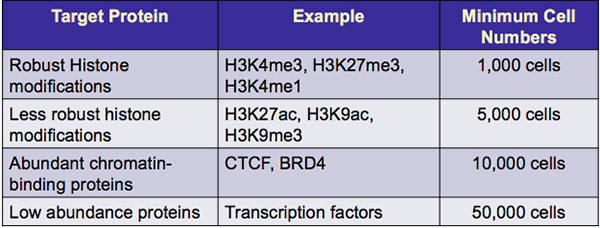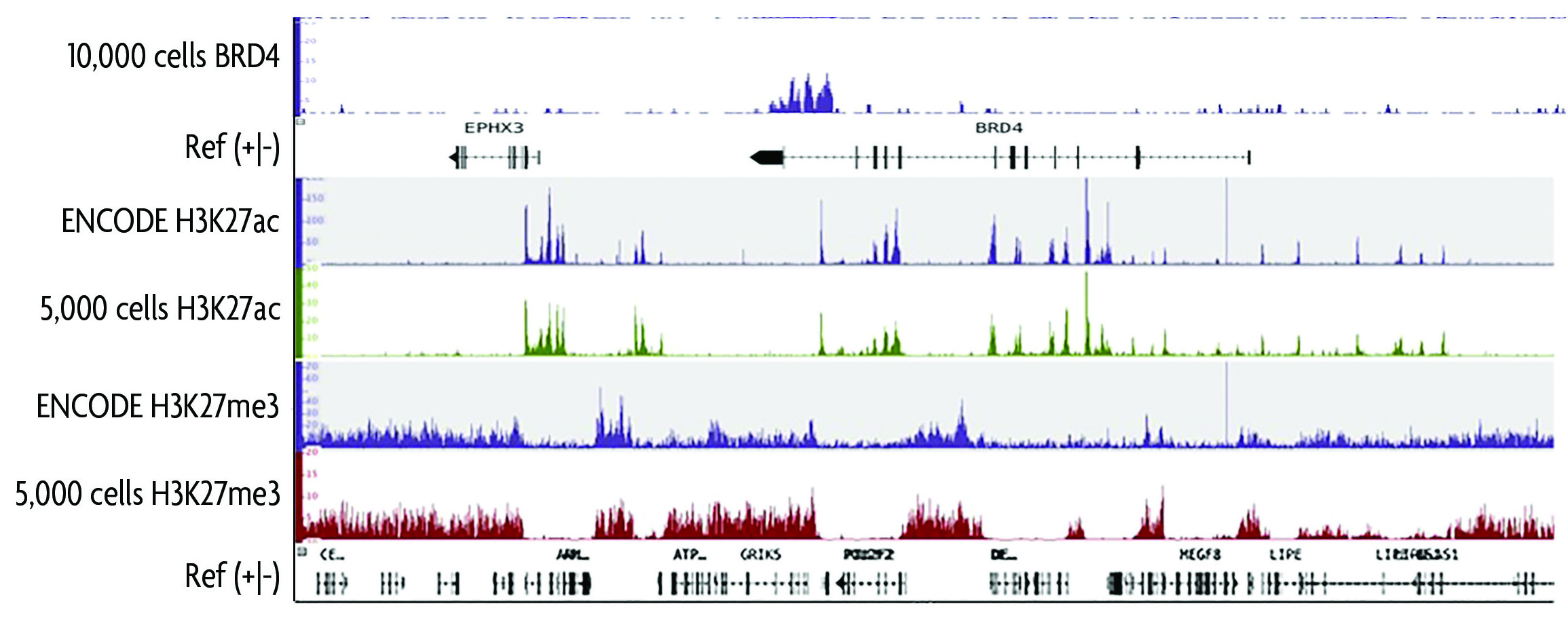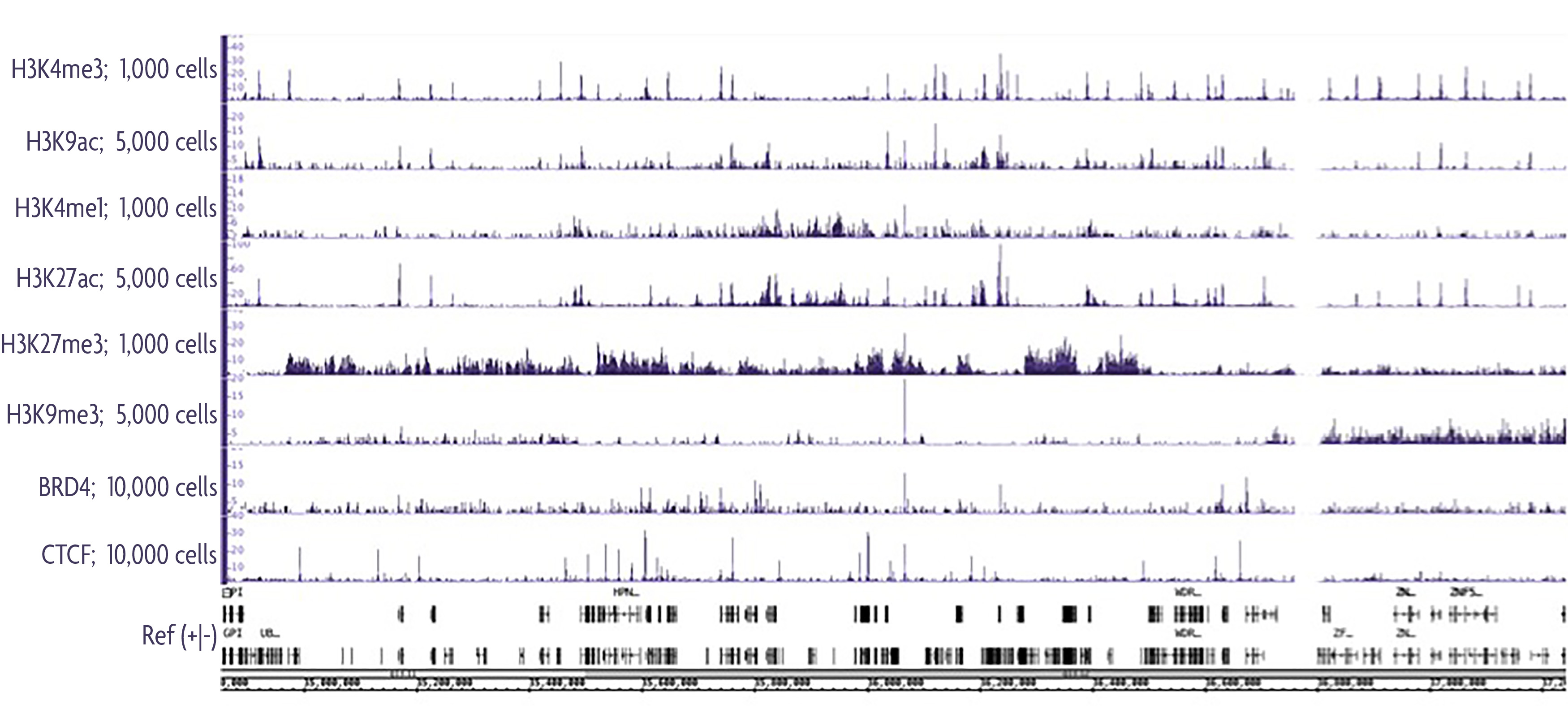Low Cell ChIP-Seq Kitの概要
本製品は販売終了となりました。
Low Cell ChIP Kitとして、NGS Library Preparation KitおよびNGS Indexing Kitを含まない状態で販売いたします。お客様のニーズに合わせて最適なNGSライブラリー調製キットをご利用ください。
このアッセイは、細胞中に多量に存在するヒストン修飾だけでなく、少量しか存在しない転写因子タンパク質にも適用できます。このキットにはIllumina®プラットフォームと互換性のある、シーケンシグライブラリーを作製するためのNext Gen DNA LibraryおよびNext Gen DNA Indexing試薬が含まれています。
ChIP-Seqは、ヒストン修飾や転写因子とゲノムDNAの結合状態をゲノム全体にわたって解析する手法で、従来1回の免疫沈降反応に、数百万個の細胞を必要としました。しかし、Low Cell ChIP-Seq Kitを使うことで、サンプルインプットの必要量を低減させられるだけでなく、少量の細胞を用いたChIPでしばしば起こるS/N比の低下や、非効率なライブラリー増幅、重複率の高さといった問題を解決できます。
Low Cell ChIP-Seq Kitの特徴
- わずか1,000個の細胞からヒストン修飾や転写因子に関する再現性の高いChIP-Seqのデータを得られます。
- キットには、クロマチン調製、免疫沈降、およびIllumina互換NGSライブラリー調製試薬が含まれます。
- ブロッキング試薬および最適化されたプロトコールによりS/N比を改善し、より良好なピークコールと低いバックグラウンドを実現します。
- 断片化重複の保持とPCR重複の除去のために分子識別子(MID)がP5アダプター内に組み込まれ、固有のアラインメントの数を増加させます。
- 一つのフローセルで最大16サンプルまで多重化できます。
Low Cell ChIP-Seq Kitは、16回のChIP-Seq反応を行うことが可能です。キットに含まれるChIP buffer、 blocker、およびprotein G Agarose Beadsなど一部の構成品は個別にご購入いただけます。
Low Cell ChIP-Seq Kitの利用は初めてですか?
Low Cell Optimization Moduleを使って成功を確実なものにしましょう!
The Low Cell ChIP-Seq Optimization Moduleには、Low Cell ChIP-Seq Kitの重要な各ステップの成否をモニターできるように、コントロールサンプル、抗体が含まれます。これらのコントロールを使って貴重なサンプルを使用する前に実験の最適化を可能にします。また、このOptimization Moduleは、少量の細胞を用いたChIP-Seqアッセイにおいて最良の結果を得るために重要となる、回収したクロマチンの品質を評価することが可能です。
Low Cell ChIP-Seqの構成品と保管温度
Low Cell ChIP-Seq Kitは、ドライアイスを入れて出荷しますが、キットには様々な保存温度の試薬等が含まれます。すべての高製品は未開封の状態で-20℃に保存可能ですが、開封後は構成品ごとに下記の温度で保存することをおすすめします。全ての試薬等は、適切に保存された場合、受け取りから6ヶ月間保証します。Protein G Agarose beadsは、溶解後に再凍結しないでください。各キットには下記の構成品が含まれます。
Reagents for Low Cell ChIP-Seq Kit
- 10X PBS; Store at -20°C
- Proteinase K (10 µg/µl); Store at -20°C
- Blocker; Store at -20°C
- Blocking Reagent AM1; Store at -20°C
- BSA; Store at -20°C
- 100 mM PMSF; Store at -20°C
- Protease Inhibitor Cocktail (PIC); Store at -20°C
- Carrier; Store at -20°C
- Fixation Buffer; Store at 4°C
- Protein G Agarose beads; Store at 4°C
- TE, pH 8.0; Store at RT
- 5 M NaCl; Store at RT
- Stop Solution; Store at RT
- ChIP Filtration Columns; Store at RT
- ChIP Buffer; Store at RT
- Wash Buffer AM1; Store at RT
- Elution Buffer AM4; Store at RT
- LiCl Buffer; Store at RT
- 1.7 ml siliconized tubes; Store at RT
Reagents for Next Gen DNA Library Kit* (included)
- Buffer W1; Store at -20°C
- Enzyme W2; Store at -20°C
- Buffer G1; Store at -20°C
- Reagent G2; Store at -20°C
- Enzyme G3; Store at -20°C
- Enzyme G4; Store at -20°C
- Buffer Y1; Store at -20°C
- Enzyme Y3 Store at -20°C
- Buffer B1; Store at -20°C
- Reagent B3; Store at -20°C
- Enzyme B4; Store at -20°C
- Enzyme B5; Store at -20°C
- Enzyme B6; Store at -20°C
- Reagent R2; Store at -20°C
- Buffer R3; Store at -20°C
- Enzyme R4; Store at -20°C
- Alu 115; Store at -20°C
- Alu 247; Store at -20°C
- PEG Solution; Store at RT
- Low EDTA TE; Store at RT
Reagents for Next Gen Indexing Kit* (included)
- Reagent Y2 Index 1; Store at -20°C
- Reagent Y2 Index 2; Store at -20°C
- Reagent Y2 Index 3; Store at -20°C
- Reagent Y2 Index 4; Store at -20°C
- Reagent Y2 Index 5; Store at -20°C
- Reagent Y2 Index 6; Store at -20°C
- Reagent Y2 Index 7; Store at -20°C
- Reagent Y2 Index 8; Store at -20°C
- Reagent Y2 Index 9; Store at -20°C
- Reagent Y2 Index 12; Store at -20°C
- Reagent Y2 Index 13; Store at -20°C
- Reagent Y2 Index 14; Store at -20°C
- Reagent Y2 Index 15; Store at -20°C
- Reagent Y2 Index 16; Store at -20°C
- Reagent Y2 Index 18; Store at -20°C
- Reagent Y2 Index 19; Store at -20°C
- Reagent R1; Store at -20°C
- Reagent B2 MID; Store at -20°C
* The Next Gen DNA Library and Next Gen Indexing Kits are powered by Swift Biosciences.
Low Cell ChIP-Seqのデータ
Low Cell Number とは?
Low Cell ChIP-Seq Kitを使えば、従来は難しいとされていた少数の細胞サンプルを用いてChIP-Seqアッセイを行うことができます。このキットは、量の限られた培養細胞や組織生検といったサンプルに対してChIP-Seqを行うのに最適です。
下記の推奨細胞数リストは1回のクロマチン調製に用いられる細胞の量です。これは、大量の細胞からクロマチンを調製した後に、それを希釈して免疫沈降したときの1回分に相当する量ではなく、ここで示す細胞数から調製したクロマチンが1回の免疫沈降反応に利用できます。

表1. Low Cell ChIP-Seq Kitの使用において必要となる最少細胞数。これらの数は、標的タンパク質の存在量および抗体の親和性に基づいています。
推奨される細胞数に影響を与えるその他の要因には細胞の種類、標的タンパク質の存在量、および抗体の品質が挙げられます。以下は、アクティブ・モティフがLow Cell ChIP-Seq Kitを用いて検証された抗体の一例です。
| Protein Target | Active Motif Catalog Number | Cell Type Tested |
|---|---|---|
| H3K4me3 | 39159 | MDA-MB-468; GM12878 |
| H3K9ac | 39918 | GM12878 |
| H3K9me3 | 39161 | GM12878 |
| H3K27ac | 39133 | HepG2 |
| H3K27me3 | 39155 | MDA-MB-468 |
| CTCF | 61311 | MDA-MB-468 |
| BRD4 | 91301 | MDA-MB-468 |
表2. Low Cell ChIP-Seq Kitで検証されたアクティブ・モティフの抗体。
アクティブ・モティフのLow Cell ChIP-Seq Kitを用いて得たデータの例。10,000個のMDA-MB-468細胞に対して抗BRD4 (bromodomain-containing 4)抗体を、5,000個のGM12878細胞に対して抗ヒストンH3K27ac抗体または抗ヒストンH3K27me3抗体を、それぞれ用いてChIP-Seqを行った。免疫沈降の後、キットに含まれるNext Gen DNA Library KitおよびNext Gen Indexing Kitsを用いてIllumina互換のシーケンシングライブラリーを生成し、NextSeq 500によりシーケンシングを行った。その結果、活性性または抑制性ヒストン修飾に対しては5,000個程度、BRD4に対しては10,000個程度の細胞から高品質なChIP-Seqのピークが得られた。

図1. Low Cell ChIP-Seq Kitを用いたときのBRD4、H3K27acおよびH3Kme3のピークをENCODEのデータセットと比較した。
存在量の多い標的タンパク質と少ないものをLow Cell ChIP-Seq Kitで解析したデータ。ヒストン修飾のH3K4me3、H3K4me1およびH3K27me3については、わずか1,000個の細胞からバックグラウンドを超える良好なピークが観察された。活性性および抑制性ヒストン修飾の両方が示されており、このキットが抑制性クロマチンを対象とする場合でも良好なChIP-Seqのシグナルを得るのに十分な感度を有することを示している。BRD4およびインスレータータンパク質であるCTCFといった低存在量のタンパク質についても、わずか10,000個の細胞から良好なChIP濃縮が可能であることが示された。

図2. ヒストンおよび低存在量のさまざまな標的に対してLow Cell ChIP-Seq Kitを用いた実験例。
Low Cell ChIP-Seq Documents
こちらもご参照ください:
| Name | Format | Cat No. | 価格 (税抜) | |
|---|---|---|---|---|
| Low Cell ChIP-Seq Kit | 16 rxns | 53084 | Discontinued | |
| ChIP Buffer | 50 ml | 37516 | ¥25,000 | Buy |
| Blocking Reagent AM1 | 0.1 ml | 37496 | ¥25,000 | Buy |
| BSA (10 mg/ml) | 0.1 ml | 37497 | ¥25,000 | Buy |
| Blocker | 0.1 ml | 37498 | ¥25,000 | Buy |
| Protein G Agarose Beads | 1.2 ml | 37499 | ¥37,000 | Buy |
| TE, pH 8.0 | 35 ml | 37515 | ¥25,000 | Buy |
What is Low Cell Number?
With Low Cell ChIP-Seq, researchers can reduce the number of cells they are studying to improve their understanding of the complexities of protein-DNA interactions to a more limited population of cells. The assay is ideal if working with limited sample amounts, hard to culture cell lines, or small tissue biopsies. The recommended cell number is the amount of cells that will be used for each chromatin preparation. The entire chromatin sample is then used in a single immunoprecipitation reaction. This differs from other ChIP assays where chromatin must be prepared from larger cell numbers and then the chromatin is diluted for use in the immunoprecipitation.

Figure 1: Table of the minimum recommended cell numbers for use with Low Cell ChIP-Seq Kit. Minimum cell numbers suggested are based on target protein abundance and antibody affinity.
Other factors that will influence the recommended cell number include cell type, abundance of target protein and the quality of the ChIP-Seq antibody. Below are some validated antibodies from Active Motif for use with Low Cell ChIP-Seq.
| Protein Target | Active Motif Catalog Number | Cell Type Tested |
|---|---|---|
| H3K4me3 | 39159 | MDA-MB-468; GM12878 |
| H3K9ac | 39918 | GM12878 |
| H3K9me3 | 39161 | GM12878 |
| H3K27ac | 39133 | HepG2 |
| H3K27me3 | 39155 | MDA-MB-468 |
| CTCF | 61311 | MDA-MB-468 |
Figure 2: Table of Active Motif's Low Cell ChIP-Seq validated antibodies.
Low Cell ChIP-Seq Data
Active Motif's Low Cell ChIP-Seq Kit was used to immunoprecipitate 10,000 MDA-MB-468 cells using an antibody directed against Bromodomain containing 4 (BRD4) protein, or 5,000 GM12878 cells using antibodies directed against Histone H3K27ac or Histone H3K27me3. Following ChIP, Illumina-compatible sequencing libraries were prepared using the included Next Gen DNA Library Kit and Next Gen Indexing Kits and sequenced using the NextSeq 500. Results show high quality ChIP-seq peaks can be obtainined using as little as 5,000 cells for both active and repressive histone modifications and as low as 10,000 cells for BRD4. Peaks were compared to ENCODE data sets using 20 million cells.

Figure 3: Low Cell ChIP-Seq peaks for BRD4, H3K27ac and H3K27me3 histone modifications compared to ENCODE data sets.
Below is a summary of Low Cell ChIP-Seq data sets using both robust and low abundance target proteins. Nice peaks above background were observed from as little as 1,000 cells for histone marks H3K4me3, H3K4me1 and H3K27me3. Both active and repressive histone modifications are shown, indicating that the method is sensitive enough to obtain good ChIP-Seq signal even when working with repressive chromatin. Lower abundance proteins, including BRD4 and insulator protein CTCF showed nice ChIP enrichment from as low as 10,000 cells. Results shown are from a single Low Cell ChIP-Seq reaction, however, data has been reproducibly generated across multiple experiments.

Figure 4: Summary of various Low Cell ChIP-Seq experiments targeting both histone and low abundance proteins.
The following publications cite the use of and/or provide additional information about the Low Cell ChIP-Seq Kit:
- Bcl11b is essential for licensing Th2 differentiation during helminth infection and allergic asthma. Lorentsen et al. (2018) Nature Communications
Contents & Storage
Please note that the Low Cell ChIP-Seq Kits are shipped on dry ice and contains reagents with multiple storage temperatures inside. All components can be stored at -20°C prior to first use, then we recommend storing each component at the temperatures indicated below. All reagents are guaranteed stable for 6 months from date of receipt when stored properly. Each kit includes the following components:
Reagents for Low Cell ChIP-Seq Kit
- 10X PBS; Store at -20°C
- Proteinase K (10 µg/µl); Store at -20°C
- Blocker; Store at -20°C
- Blocking Reagent AM1; Store at -20°C
- BSA; Store at -20°C
- 100 mM PMSF; Store at -20°C
- Protease Inhibitor Cocktail (PIC); Store at -20°C
- Carrier; Store at -20°C
- Fixation Buffer; Store at 4°C
- Protein G Agarose beads; Store at 4°C
- TE, pH 8.0; Store at RT
- 5 M NaCl; Store at RT
- Stop Solution; Store at RT
- ChIP Filtration Columns; Store at RT
- ChIP Buffer; Store at RT
- Wash Buffer AM1; Store at RT
- Elution Buffer AM4; Store at RT
- LiCl Buffer; Store at RT
- 1.7 ml siliconized tubes; Store at RT
Reagents for Next Gen DNA Library Kit* (included)
- Buffer W1; Store at -20°C
- Enzyme W2; Store at -20°C
- Buffer G1; Store at -20°C
- Reagent G2; Store at -20°C
- Enzyme G3; Store at -20°C
- Enzyme G4; Store at -20°C
- Buffer Y1; Store at -20°C
- Enzyme Y3 Store at -20°C
- Buffer B1; Store at -20°C
- Reagent B3; Store at -20°C
- Enzyme B4; Store at -20°C
- Enzyme B5; Store at -20°C
- Enzyme B6; Store at -20°C
- Reagent R2; Store at -20°C
- Buffer R3; Store at -20°C
- Enzyme R4; Store at -20°C
- Alu 115; Store at -20°C
- Alu 247; Store at -20°C
- PEG Solution; Store at RT
- Low EDTA TE; Store at RT
Reagents for Next Gen Indexing Kit* (included)
- Reagent Y2 Index 1; Store at -20°C
- Reagent Y2 Index 2; Store at -20°C
- Reagent Y2 Index 3; Store at -20°C
- Reagent Y2 Index 4; Store at -20°C
- Reagent Y2 Index 5; Store at -20°C
- Reagent Y2 Index 6; Store at -20°C
- Reagent Y2 Index 7; Store at -20°C
- Reagent Y2 Index 8; Store at -20°C
- Reagent Y2 Index 9; Store at -20°C
- Reagent Y2 Index 12; Store at -20°C
- Reagent Y2 Index 13; Store at -20°C
- Reagent Y2 Index 14; Store at -20°C
- Reagent Y2 Index 15; Store at -20°C
- Reagent Y2 Index 16; Store at -20°C
- Reagent Y2 Index 18; Store at -20°C
- Reagent Y2 Index 19; Store at -20°C
- Reagent R1; Store at -20°C
- Reagent B2 MID; Store at -20°C
* The Next Gen DNA Library and Next Gen Indexing Kits are powered by Swift Biosciences.


